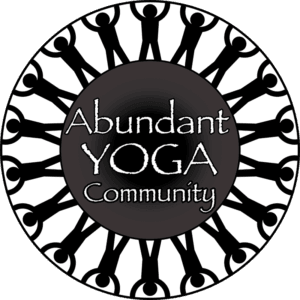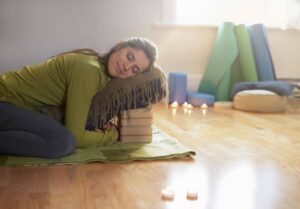As a newcomer to yoga, it’s not uncommon to feel intimidated by the other students in the class and assume that they’re all seasoned practitioners who have mastered the practice. You may find yourself making comparisons and assuming that they possess advanced skills, are well-connected with the instructor, and have the best yoga gear. This can lead many people to hesitate before stepping into their first class. They may be unsure of what to wear, what to bring, or what type of class to try.
In this post, we aim to address these concerns and provide you with the basics you need to feel comfortable walking into your first class. We’ll answer questions like whether you need to bring a mat, whether shorts or leggings are best, and what to expect during savasana. It’s important to remember that everyone starts somewhere, and yoga is a practice that focuses on progress over perfection. Our goal is to help you feel empowered and confident as you begin your yoga journey.
At the Abundant Yoga Community, we believe that yoga is beneficial to all, therefore it should be accessible to all. Our non-profit organization helps bring yoga to people who might not otherwise have access due to financial or geographical constraints. We offer grants and scholarships, and we partner with local studios like Inspiring Actions (Hudson and River Falls) and Healing Roots Wellness Center (River Falls) to provide free yoga events to our community.
Keep reading for everything you need to know for your first yoga class!
What to Expect at a Yoga Class
What to wear.
In a typical yoga class, you’ll do plenty of twisting, stretching, and moving around so your attire should be comfortable and allow for mobility. You do not have to have a three-hundred-dollar, name-brand yoga outfit; any tight-fitting, comfortable clothing will do! Leggings, bike shorts, or yoga pants with elastic ankles are all ideal options. If you go with shorts, make sure they’re long enough to cover yourself for poses like happy baby where your legs are in the air.
What to bring.
When attending a yoga class, bringing a few key items can help to enhance your experience and make the most of your practice. One essential item is a yoga mat, which provides a non-slip surface for your practice and helps to cushion your joints during certain poses. If you have your own mat, you can bring it along with you to the class. If you don’t, it’s likely the studio provides them, but it doesn’t hurt to check ahead of time. Another important item to bring is a water bottle, which will help you stay hydrated throughout the practice. It’s important to drink plenty of water before, during, and after class to help flush out toxins and keep your body functioning at its best. Along with these physical items, it can also be helpful to bring an intention with you to the class. This may be a word or phrase that represents a quality or feeling you want to cultivate during your practice, such as gratitude, peace, or strength. By setting an intention for your practice, you can help to create a focused and meaningful experience that goes beyond just the physical postures.
What to expect.
When you attend a yoga class, you can expect to engage in a practice that combines physical movement, breathwork, and mindfulness. The class will typically begin with some centering and grounding exercises, such as breathing exercises known as pranayama, or meditation, to help you connect with the present moment. From there, you’ll move through a series of yoga poses, which may include standing, seated, or balancing postures, among others. Your instructor will guide you through each pose, offering modifications and adjustments as needed to help you deepen your practice in a way that’s comfortable for your body. Throughout the class, you’ll be encouraged to focus on your breath and stay present in the moment, which helps calm the mind and reduce stress.
Classes typically end in savasana, or corpse pose, which is a relaxation pose that allows your body to fully release tension and integrate the benefits of the practice. During savasana, you’ll lie on your back with your eyes closed, completely surrendering your body to the ground. You may be guided through a body scan, in which you mentally focus on each part of your body and consciously release any remaining tension. In this pose, your breathing will naturally slow down, allowing your body to shift into a state of deep relaxation. By the end of the practice, you should feel a sense of deep calm and inner peace, as well as a renewed sense of energy and focus. This final relaxation is an essential part of the practice, as it allows you to fully integrate the physical, mental, and emotional benefits of the class. It’s important to give yourself enough time in savasana to fully surrender and absorb the effects of the practice before getting up and returning to your daily life.
Common Yoga Poses
In the practice of yoga, there are several poses that are commonly incorporated into various styles and types of classes. These poses can help to improve flexibility, strength, balance, and overall well-being. As a beginner to yoga, it can be helpful to familiarize yourself with some of these common poses so that you feel more prepared and confident when walking into your first class. By practicing these poses and becoming familiar with their alignment and cues, you’ll be better prepared to participate in a yoga class with confidence and ease. Here are some of the most commonly practiced yoga poses and instructions on how to do them:
1. Mountain Pose: Stand tall with your feet hip-width apart, arms at your sides, and shoulders relaxed. Engage your leg muscles and draw your navel in towards your spine. Ground down through your feet and imagine a string pulling the crown of your head up towards the ceiling.
2. Downward-Facing Dog: Begin on your hands and knees with your wrists under your shoulders and your knees under your hips. Spread your fingers wide and press your palms into the mat. Tuck your toes under and lift your hips up and back, straightening your arms and legs.
3. Child’s Pose: Starting on your hands and knees, lower your hips back towards your heels and stretch your arms out in front of you. Rest your forehead on the mat and breathe deeply into your back body.
4. Warrior II: From standing, step your left foot back and turn your toes out to a 90-degree angle. Bend your right knee so that it’s directly over your ankle, and stretch your arms out to the sides. Gaze over your right fingertips and engage your core and leg muscles.
5. Tree Pose: Stand tall with your feet hip-width apart and your arms at your sides. Shift your weight onto your left foot and lift your right foot off the ground, placing the sole of your foot on your left inner thigh. Press your foot into your thigh and your thigh into your foot, and bring your hands to your heart center.
—
If you are interested in trying yoga but have financial or geographical constraints that are holding you back, the Abundant Yoga Community may be able to help you. Fill out an application for a personal scholarship, or a grant for a group event. You can also check out our free yoga events happening monthly in the St. Croix Valley! Interested in bringing the gift of yoga to others? Click here to read more about business and personal memberships, as well as how to make a one-time donation. Your contribution makes a significant impact by bringing yoga to our community and helping to create a more positive and harmonious environment.




